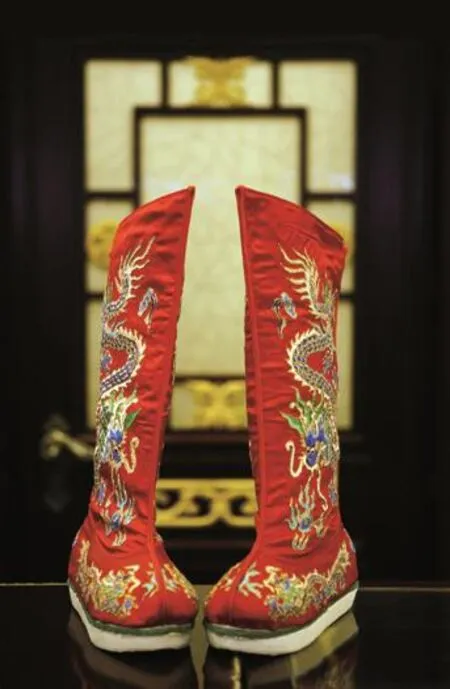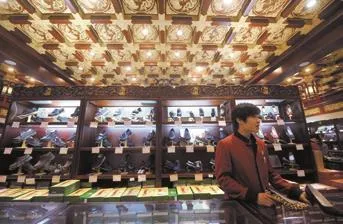Old Soles
By Yu Yan
Old Soles
By Yu Yan
Beijing shoe brand Neiliansheng keeps cultural heritage running

DRAGON BOOTS: Neiliansheng presents a pair of special cloth boots to female shoe buyers
Amid the rhythmic tap-dance of production inside Neiliansheng’s factory in Xicheng District of Beijing, He Kaiying, a master of Neiliansheng cloth shoes, was teaching an apprentice to draw the outline of a sole. The 56-year-old senior shoemaker guides three young apprentices, passing on traditional shoemaking skills that have been in place since the company’s establishment.
Neiliansheng, which means “unstopped promotions in official ranks” in Chinese, is a classic cloth shoe brand created in Beijing in 1853. It once provided shoes for emperors and royal court offcials. At that time, wearing the court shoes of Neiliansheng was a fashion statement in Beijing and a mark of high status.
The craft of multi-layer-sole cloth shoe was listed on China’s second intangible cultural heritage list in 2008. Today, it remains China’s biggest manufacturer of hand-made cloth shoes.
“Neiliansheng’s shoes are nice and cool in the summer and they don’t pinch my feet,”said Yu Shouzhong, a customer. “In winter, I wear thicker ones with feece inside, they are even warmer than leather boots.”
Sole inheritor
Neiliansheng shoes are hand-made, using pure natural materials such as cotton, hemp, wool or silk. The cloth should be rinsed and starched. Then, workers steam, overlap and stitch the cloth into soles. It takes a worker at least four days to make one pair of Neiliansheng shoes, said He. Each square of sole requires at least 81 stitches. As a result, making a pair of soles requires about 5,000 stitches. The sole made under such a process is more comfortable than those made of leather and it hardly deforms or cracks.
Making the delicate cloth shoes by hand is no easy task. A worker must bend his back, neck and legs in order to gain the leverage needed. Every day, He sits on a bench for several hours to sole the shoes, concentrating on each step.
“We can’t allow this cultural heritage to disappear,” said He.
As the brand’s leading shoemaker, He has been given the title of state-level cultural heritage inheritor.
In 2008, to meet the needs of elderly customers, He restored the skill of making shoes that ft both feet.
“Usually, a pair of shoes distinguishes the left foot and the right foot,” He said. “Many senior citizens find it inconvenient. In its history, Neiliansheng once produced shoes tailored for the elderly, but the skill disappeared. In recent years, many elderly people came to us for this kind of shoes. So we looked through the records, consulted veteran shoemaking masters and restored the skill.”
Currently, this special kind of shoes has been reproduced and is on sale in the market.
The key to preserving a skill is to pass it on to the younger generation. This is what He has been doing in recent years. He has been teaching his three apprentices—Ren Chenyang, Cai Wenke and Zhao Guosheng—step by step.
The 27-year-old Zhao is the youngest of the three. As soon as he entered Neiliansheng, he was shocked by the skillset that goes into production.
“The skills that our master has taught us are unique and cannot be replaced by machines,” said Zhao. Zhao is now responsible for quality monitoring.
Building reputations
“Virtue is as important as good skills. A person without virtue can’t make good shoes,”He asserted. He has always advised his apprentices to have strong service awareness and build a good reputation.
Ren will never forget the first time he measured a customer’s feet to make shoes. Although He taught him patiently, it still didn’t go smoothly. Ren made the shoes four times before they perfectly ft the customer’s feet.
“Master He taught us how to measure customers’ feet correctly, and that we should put the customer’s feelings in the frst place, and remember the customers’ foot shape clearly,” Ren said.
One day, a 70-year-old man came to the store to order a pair of hand-made cloth shoes. Seeing Ren was so young, the elderly was a little disconcerted. One month later, Ren handed the finished shoes to him. The old man put them on, walked around the store and gave him a thumbs up.

NEW STYLES: A salesperson of Neiliansheng introduces high-heeled cloth shoes to customers
“Master He is very strict with us at work,”said Cai, another apprentice of He. Once, Cai received a phone call while sewing a sole, leaving the stitching awl inside the shoe. As soon as He saw this, he criticized Cai harshly. Since then, Cai has been mindful of working with respect.
He’s three apprentices have all become excellent shoemakers. But in their eyes, there is still a long way to go before catching up with their master, both in skills and in career reputation.
Future
“It is now the best time for Neiliansheng’s development,” said Cheng Laixiang, General Manager of Neiliansheng. In 2000, the company’s sales revenue was no more than 15 million yuan ($2.37 million). After the company upgraded its operation model in 2001, the fgure surged to 84.89 million yuan ($13.40 million) and is expected to surpass 100 million yuan ($15.79 million) this year.
The key to the revitalization of the time-honored brand lies in its continuous innovation.
The company strives to expand its target consumers. Before, it only made men’s shoes, but now it makes shoes for women and children. It used to offer only one style of shoes, and all of them were in black. But it now makes shoes with more than 3,000 different styles. Also, it has explored online sales to meet the demand of young people.
“Now our customers include people of all ages. Our research and development cover infants’ shoes, children’s shoes, students’ shoes, seniors’ shoes and so on,” said He.
Today, anyone can enjoy the company’s customized services. In September 2009, the company’s head offce in Dashilar of Beijing offcially launched this service to the public. The customer can choose his or her favorite fabric and pattern from dozens of options. The customers’ foot sizes and preferences will be saved in the computer so that they need not to come to the offce again for measurement the next time he orders shoes.
The introduction of modern management has brought a fresh start to Neiliansheng. However, the classic brand has never changed its tradition of making cloth shoes.
The company has put great importance on cultivating a team of inheritors to learn this cultural heritage. Mentors oversee every step of the shoemaking process to ensure the tradition is carried on. Furthermore, the company emphasizes brand-name quality over quick profts. Many overseas Beijingers will buy a pair of cloth shoes by Neiliansheng when they return to China.
Hopefully, by following in the footsteps of traditional shoemakers like He, this cultural heritage will be passed on for generations, said Cheng.
yuyan@bjreview.com

